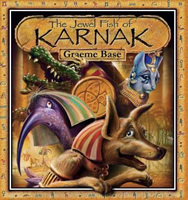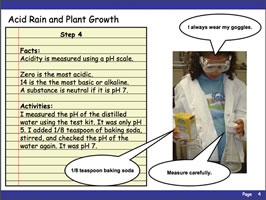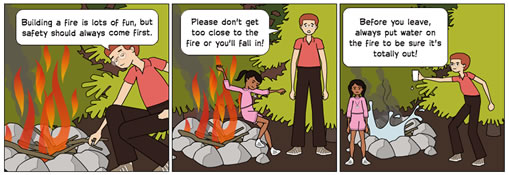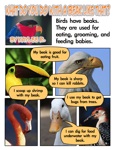Graphic Inquiry & Dynamic Differentiation
 Learn to differentiate with technology-enhanced graphic tools and resources.
Learn to differentiate with technology-enhanced graphic tools and resources.
Build authentic learning environments through object- and place-based inquiries. Illuminate projects and nurture digital citizens.
On this page, we'll explore ways to combine content from various subject areas such as language arts, science, social studies, and math with information and technology skills and strategies to meet diverse learning needs and address Standards for the 21st Century Learner.
Dynamic Differentiation
Each child is unique. Use technology to address these differences! Work as an educational team to focus on the needs of subgroups in the classroom. Collaborate on the development of learning experiences that address student readiness, personal interests, and engaging choices.
Differentiated instruction was first identified by Carol Ann Tomlinson in the 1990s as a way to provide different avenues for students to construct knowledge. Consider ways to combine traditional resources with 21st century technologies to meet the needs of all students.
An Example
 Let's use the book The Jewel Fish of Karnack by Graeme Base as an example. Watch the video to learn more about the author, book, and game. Read the book. Then, go to the website to solve the puzzle. Use KeepVid to download the video for use with a class. Consider the many ways that this book could be used to jumpstart learning.
Let's use the book The Jewel Fish of Karnack by Graeme Base as an example. Watch the video to learn more about the author, book, and game. Read the book. Then, go to the website to solve the puzzle. Use KeepVid to download the video for use with a class. Consider the many ways that this book could be used to jumpstart learning.
First, think about how the book mixes nonfiction with a fictional story. For instance, read the inside of The Jewel Fish of Karnak book cover for background information about the facts related to the story set in Ancient Egypt.
How could you connect other works of fiction with factual information and content area standards?
Second, look for visual elements, codes, games, and other elements that will bring content area learning alive. For instance, The Jewel Fish of Karnak includes history-based characters, hieroglyphs, and other interesting elements.
What other picture books have interesting visual elements that could expand interest?
Third, use the author's website materials including videos, games, mysteries, and other elements to bring reading alive. For instance, Graeme Base's website contains a video that introduces the book and challenges, a game area, and other interesting information.
What authors have great resources you can use to expand a reading experience?
The Problem... Most books don't have great nonfiction resources and fun games.
The Solution... Build your own!
To find great resources, do a Google search for your topic and add the word "pathfinder" to see what other librarians and classroom teachers have created such as Ancient Egypt.
There are many great books set in Ancient Egypt such as:
- Bill and Pete Go Down the Nile by Tomie dePaola
- Cleopatra VII: Daughter of the Nile by Kristiana Gregory
- Egyptian Cinderella by Shirley Climo
- I am the Mummy Nefert by Eve Bunting
- Mrs. Frizzle's Adventures in Ancient Egypt by Joanna Cole
- Mummies in the Morning by Mary Pope Osborne
- Muti's Necklace by Louise Hawes
- Pepi and the Secret Names by Jill Paton Walsh
- Sphinx's Princess by Esther Friesner
- The 5000 Year Old Puzzle by Claudia Logan
- The Time Warp Trio: Tut, Tut by Jon Scieszka
- We're Sailing Down the Nile by Laurie Krebs and Anne Wilson
Much of The Magic and the Mummy by Terry Deary can be read at Google Books. Use these previews to generate interest.
Infuse quality, nonfiction resources associated with the work of fiction:
- BBC
- British Museum
- Canadian Museum of Civilization
- Egyptian Mythology
- Eternal Egypt
- Great Scott
- Mr. Donn's Ancient Egypt
- National Gallery of Art
- National Geographic
- Hieroglyphs
- Museum of Science
- Neferchichi's Tomb
- Odyssey Online
- PBS, PBS, PBS, NOVA
- Royal Ontario Museum
- Scholastic
- Smithsonian Journey
- Tour Egypt
 Integrate graphic and interactive elements:
Integrate graphic and interactive elements:
- Go to NOVA to do a 360-exploration virtual trip.
- Go to Discovery to Build a Pyramid.
- Locate charts, timelines, and maps at the Royal Ontario Museum.
- Try the hieroglyphic typewriter, hieroglyphs translator, or make your own cartouche.
- Try iPad apps like Egypt Engineering.
- Explore student projects.
Select a visually rich book and consider the many ways it could be used.
For instance, Wonderstruck by Brian Selznick tells two stories: one visual and one text. Google Books has a nice preview to give you the sense of the book.
Also, think about the nonfiction resources that could accompany the book such as ASL (American Sign Language) and the American Museum of Natural History, Museum of Jurassic Technology resources.
For more ideas, check out the Wonderstruck Pathfinder.
Differentiate with Graphics
Match content-area and 21st century standards with the types of graphics that young people may use as part of an inquiry. Consider activities that address individual differences, readiness, interests, and choice.
 Some students are successful with a lecture and a textbook. While others need practice, a chance to explore a range of resources, and varied experiences.
Some students are successful with a lecture and a textbook. While others need practice, a chance to explore a range of resources, and varied experiences.
Think about ways to transform the exploration of acid rain, the water cycle, and the environment through the use of graphics.
- A learner who has difficulty with a traditional written science log assignment may be more successful photographing the process.
- A learner may use a map to better understand the relationship between weather patterns and acid rain.
- A learner may use historical photos to see how smoke and acid rain impact cars.
- A Venn diagram may be used to compare sources of pollution in two counties.
- A timeline may document changes in air quality regulation over time.
Let's explore six types of graphics that work well for differentiation: illustration, data sets, infographics, maps, organizers, and photos.
Data
Data is a collection of facts that are the result of observation, experience, or experiments. Students can use charts and graphics to better understand data and convey their own work.
Student enjoy timely information that connects with their life. Involve students in using information from the 2010 US Census in their inquiries. Start with national data, then ask them to look at state and local trends.
Involve students in analyzing existing data sources and collecting their own data. For instance, students might compare the chart found at USA Today Snapshots with an inventory of the food in their own home. The online tool Create a Graph works well for students creating their own graphs.
Keep it simple. Read Right Outside My Window by Mary Ann Hoberman. Create a predicted and actual temperature chart. Involve students in taking photographs of the different seasons.
Illustration
Challenge student thinking by presenting young people with unusual images. For instance, many students have seen Civil War photographs, but have they seen drawings? Use visual variety to enrich the learning experience.
Involve students in analyzing illustrations.Explore WPA posters. Ask questions such as:
- Who created it?
- What's the purpose?
- What's the intended audience?
- Was the image created from first-hand experience?
- Is it truthful?
- Is it posed?
- Is it biased?
- Is it time specific?
Comics and illustrated books are being produced by many groups:
- Federal Agencies: On the Trail of the Missing Ozone, Ready Kids
Show students Public Service Announcement Comics and have them make their own:
- PSA Comic: Bat Bites
- Online Comic Makers: MakeBeliefsComix, Pixton - Fire Safety, ToonDoo - Bullying Comics
- Comics Software: Comic Life
Connect graphic histories with practical visual products.
- Read Journey to Mohawk Country. Compare the original journals to the graphic history.
- Explore student projects at Kids Illustrate blog.
- Involve students in creating their own graphic history.
Infographics
Infographics has become a popular way to visually represent many forms of information. Students develop and apply evaluation skills when they analyze infographics such as The Tongue.
Explore different types of infographics, then create your own:
- Explore A Disaster for FEMA. Learn more about one of these types of disasters.
- Explore How Dangerous is Your House? Do your own study.
The Learning Network at the New York Times did a nice series on teaching with Infographics:
- Teaching with Infographics: Places to Start
- Teaching with Infographics: Social Studies
- Teaching with Infographics: English
- Teaching with Infographics: Science and Health
- Data Visualized
Explore lots of examples:
- Cool InfoGraphics
- Data Visualization
- Flowing Data
- Gapminder
- Good
- Good Transparency
- Hipmunk Flight Search
- Infographics Showcase
- Joe Lertola
- NMap
- USA Today Snapshots
- Visual Economics
- Visualizing.org
Try some infographic apps for your iPad. Learn more at 10 Infographics and Visualization Apps for iOS.
Maps
Maps are a powerful way to meet the visual needs of young people. They can help students identify locations, routes, and patterns. This type of visual thinking can be very helpful across the curriculum:
- Explore the Cancer Mortality Maps and speculate on why some areas have more of a particular type of cancer. Ask students to locate evidence to support their claim.
- Explore HowBigReally. Use it to help students visualize sizes in the world. Use Google Maps to create your own.
- Explore A Literary Map of Manhattan. Could you make one for your state, city, or country? Get students involved with creating their own maps using Google Maps.
- Think about activities that involve students in analyzng and creating maps. Explore other maps: CDC Flu Map, Environmental Disasters, Tracking the Oil Spill, Water Maps, What's in the Trash?
- Example the Lyme Disease Map. Make prediction using evidence to support the prediction.
- Use the US Government Map Master List for many more map examples.
Use historical maps to analyze a particular place such as Manhattan. Ask students to:
- Identify place
- Identify change
- Make predictions
- Ask big questions
Ask students to analyze the past, create the present, and make comparisons.
Explore a class project called Mapping the World by Heart. They used the Mapping the World by Heart materials as the basis for their project.
Organizers
Organizers help young people think about the content they are exploring. Use organizers as an alternative to traditional writing activities. After reading First the Egg by Laura Vaccaro Seeger, ask students to create a process organizer showing the entire process for one of the examples in the book. Use organizers as a guide for writing. Some students have a hard time getting started. Ask them to make a likes and dislikes chart for preplanning. While reading The Calder Game by Blue Balliett students reflected on photographs of sculptures.
In the article Guiding Students with Eight Types of Graphic Organizers, Gallavan and Kottler describe how organizers can be used to share knowledge. These can be applied to the study of animals using book such as Nic Bishop's Marsupials. As students conduct inquiries, they can share their understandings in the following categories:
- Assume and Anticipate
- Position and Pattern
- Group and Organize
- Evaluate and Estimate
- Compare and Contrast
- Relate and Reason
- Identify and Imagine
Organizers are a great way for students to think about key ideas before they begin a writing project. It's also a great way to discourage plagiarism.
Photos
With easy access to digital cameras, think about ways to differentiate with photography.
Involve students in photographing both the process and products involved in projects.
Read Diary of a Worm by Doreen Cronin. Use a digital camera to photograph a composting project.
Teach young people to critically analyze photographs. For instance, Edward S. Curtis's photos of Native American people are well-known. Are they stereotypes? Are they posed? Does this make a difference? Do they reflect the times they were taken?
Ask students to think about the use of photo editing tools. How does cropping an image impact the message?
In his book How to Interpret Visual Resources, Harry Stein stresses four ideas when examining images:
- First impressions
- Feelings
- Connecting to personal experiences
- Last impressions: revisiting an image
Use DocsTeach from Library of Congress to help students analyze and work with images as visual evidence.
Ask students to analyze an image that representing a position opposed to their own thinking (see example below left).
In many cases, it's a good idea to create a model so students can see the expectations. This was done with the comic based on the book What Would You Do with a Tail Like This? by Steve Jenkins (see example below center).
Ask students to incorporate historical images into their projects. For instance, young people were asked to create a public service announcements applying historical images to a current issue. In this case, the student applied images related to the Civil Rights Movement to the Gay Marriage Issue (see example below right).
Use websites such as PicLits to engage students in writing about photos.
Learning through Graphic Inquiry
Graphic inquiry involves weaving visual representations throughout the inquiry process. If you're exploring the world of sharks bring in books, videos, and shark teeth. Get students involved with creating models, drawings, and videos.
 Infuse graphic representations into text-heavy lessons such as the poetry of Walt Whitman. Use the picture book along with historical photos from Library of Congress.
Infuse graphic representations into text-heavy lessons such as the poetry of Walt Whitman. Use the picture book along with historical photos from Library of Congress.
Differentiate throughout the learning experience:
- Content. Students might have many books to choose from with different ways of approaching the content and different reading levels such as Uno's Garden by Grame Base and The Evolution of Calpurnia Tate by Jacqueline Kelly.
- Process. Students may have choices in the topics they select as they are exploring the resources at e-nature.
- Product. Students might write paragraphs, but they might also create a map, chart, graph, or scrapbook of their results.
Let's explore three types of learning that work well with differentiation and digital age projects.
Object-based Learning
Artifacts and objects can serve as inspiration for exciting, inquiry-based learning experiences. Objects are living and nonliving natural objects such as shells.
Ask students to explore interesting objects. The book Object-Based Learning Using Everyday Objects by Amy Edmonds Alvarado has lots of ideas for object-based learning.
Rather than a final product, consider an incomplete object such as "what did Abraham Lincoln's statue look like before it was completed?"
Incorporate digital cameras into object-based products along with classic books such as The Fall of Freddie the Leaf by Leo Buscaglia.
Involve students in taking photographs of their dioramas and other projects. Or, create diagrams for their projects.
Read Measuring Penny by Loreen Leedy. If you want to incorporate objects you don't have, use Pective for the sizes.
Use museum websites for locating online artifacts that go with history projects. Go to Smithsonian's History Explorer: Museum Artifacts and Within These Walls.
Place-based Learning
Place-based learning connects students with the local community by grounding experiences in local phenomena. For instance, after exploring The Freedom Trail in Boston, they might create their own using Google Maps.
Create ongoing activities that involve students in learning about local history such as the Montana Heritage Project.
Explore local issues such as Coal Mining and ask students to use tools such as Animoto to create their own communications.
Think about how the school library can support these types of activities by checking out kits that contain GPS devices, digital cameras, clipboards, testing equipment, and other mateirals.
Project-based Learning
Graphic elements can be incorporated into many types of student projects.
 Students exploring celebrations might start by creating a graphic organizer in Bubbl, download photos of current and historical events, and create a wall mural as a group.
Students exploring celebrations might start by creating a graphic organizer in Bubbl, download photos of current and historical events, and create a wall mural as a group.
Students help to solve the mystery of unfinished stories using pictures from The Mysteries of Harris Burdick. Check out a blog where students shared their results.
Help your teachers find ways to differentiate through the use of visual elements. Use books like A Bee in a Cathedral and 99 Other Scientific Analogies by Joel Levy to model and stimulate creative thinking.
Keep your eye out for new online tools for creating infographics and other interesting ways to share understandings. Visual.ly is still in the development phase, but it has lots of potential.



